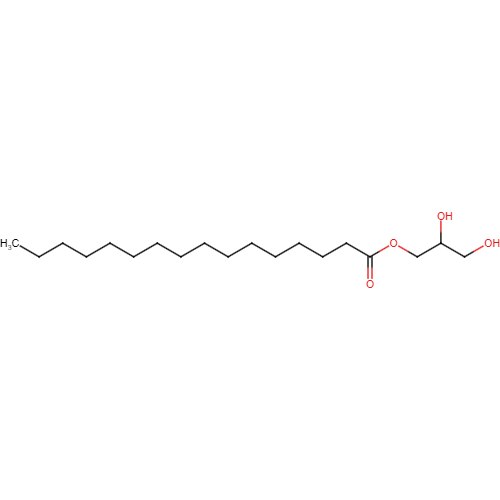2,3-Dihydroxypropyl hexadecanoate
| Compound Structure: |

|
||||||||||||||||||||||||||||||||||||||||
|---|---|---|---|---|---|---|---|---|---|---|---|---|---|---|---|---|---|---|---|---|---|---|---|---|---|---|---|---|---|---|---|---|---|---|---|---|---|---|---|---|---|
| Synonyms: | Monopalmitin;1-Monopalmitin;1-Palmitoyl-rac-glycerol;GLYCERYL PALMITATE;2,3-dihydroxypropyl hexadecanoate;1-Palmitoylglycerol;Glycerol 1-monopalmitate;Glycerol 1-palmitate;Glycerol 3-palmitate | ||||||||||||||||||||||||||||||||||||||||
| Compound ID: | NMPC-100 | ||||||||||||||||||||||||||||||||||||||||
| PubChem ID: | |||||||||||||||||||||||||||||||||||||||||
| Molecular Formula: | C19H38O4 | ||||||||||||||||||||||||||||||||||||||||
| Canonical SMILES: | CCCCCCCCCCCCCCCC(=O)OCC(CO)O | ||||||||||||||||||||||||||||||||||||||||
| InChIKey: | QHZLMUACJMDIAE-UHFFFAOYSA-N | ||||||||||||||||||||||||||||||||||||||||
| About the compound: | 1-monopalmitoylglycerol is a 1-monoglyceride, characterized by having palmitoyl as the acyl group. It is naturally found in Neolitsea daibuensis and serves roles as a plant metabolite and an algal metabolite. Functionally, it is related to hexadecanoic acid. Glyceryl palmitate is another natural compound, discovered in various organisms including Astragalus mongholicus and Euphorbia micractina. GHS Hazard Statements • H411 (100%): Toxic to aquatic life with long lasting effects [Hazardous to the aquatic environment, long-term hazard] |
||||||||||||||||||||||||||||||||||||||||
| Properties: |
Chemical and Physical Properties
|
||||||||||||||||||||||||||||||||||||||||
| Source Species: |
Acanthus montanus Senna tora Tragia benthamii |